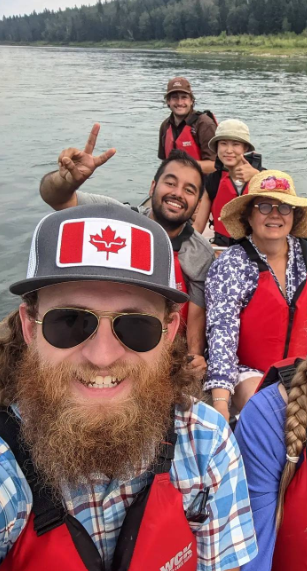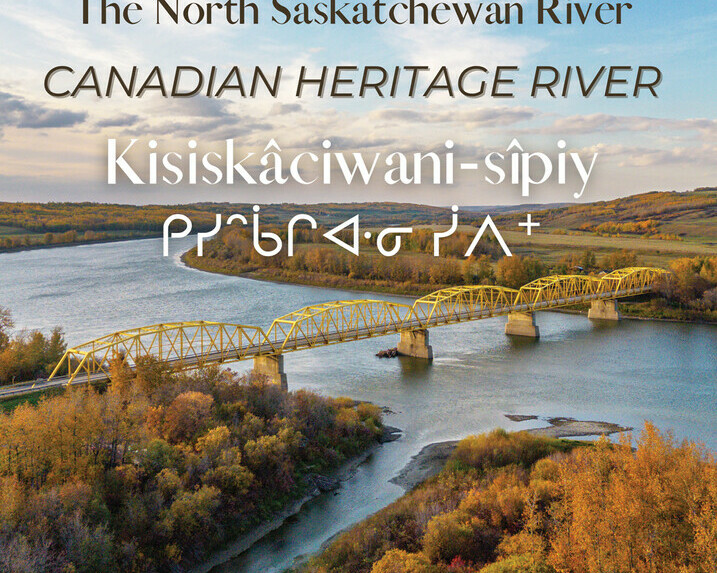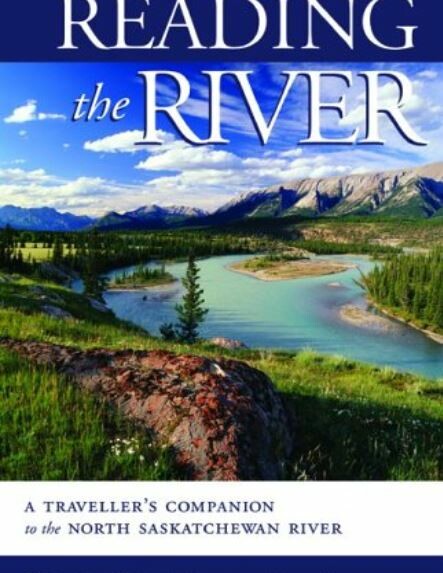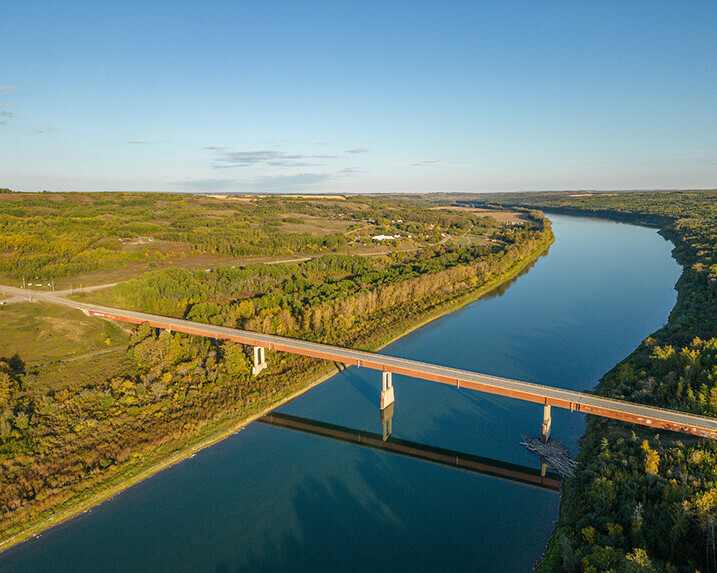
A Two Decade Journey
In hopes of getting the river designated over 20 years ago, the NSWA was asked to put together an extensive background study on the North Saskatchewan River’s general characteristics, natural features, and history. Communications coordinator, Billie Milholland, took on the task and completed this work in 2005.
Former Executive Director of the NSWA, Dave Trew, says that after Milholland finished the study, the province was contacted for support to move things forward. While initial conversations with the province went well, the NSWA was very busy for several years creating and mobilizing the Integrated Watershed Management Plan. The province was also focused elsewhere, so the designation process slowed down and lost momentum.
GETTING BACK IN THE FLOW
In 2019, Kyle Schole was hired as a Planning Assistant for Smoky Lake County. He began working on some economic development for the Victoria Settlement National Historic Site, which features Métis Crossing. Schole says, “The value of seeking a designation for the river itself leant neatly to some of that work,” because it connects the river to broader “storytelling and intercultural exchange”.
Schole admits that they weren’t sure where to start on the designation process, so they reached out to the NSWA. He says that having access to the “substantial piece of work” produced by Milholland was a huge asset that allowed them to simply update and modernize some of that information.
The nomination was completed in August 2021 and acceptance of a subsequent document brought the process to completion. The Heritage River designation was officially announced online by the Province of Alberta and the Government of Canada on March 22, 2024 – World Water Day.
TELLING OUR STORIES OF PLACE
The project and its value resonated with a lot of people. “Most people got it and immediately latched onto it on a personal level,” says Schole. This included people from a diverse range of communities, cultures, geographies, and cultures. Schole found it interesting that people were quick to bring up stories of “experiences they’ve had near the river or on the river. It serves as a vehicle for them to tell those stories and share those stories. And to better understand how this matters to different people in different ways.”
GRATEFUL TO BE PART OF THE PROCESS
Schole says that some of the most gratifying work of the last few years was engaging with indigenous communities and community members. “If there was a single part of the work that I’m most proud of, it was the report led by pipikwan pêhtâkwan (pee-pee-gwan pee-tah-gwan) that summarizes the Indigenous engagement undertaken to-date and begins to set the stage for options and opportunities of what could come next.” He adds that this designation “living”, explaining that it’s not meant to “sit on the shelf and collect dust”.
For some, the focus of the designation will be on stewardship; for others it will be about increasing tourist and recreational opportunities. It provides a means of bringing municipalities together – in some similar ways to the work of watershed alliances – in terms of broader planning and innovation. There are also a range of opportunities for cross-cultural partnerships with Indigenous and Métis communities.
Schole is grateful to his fellow Smoky Lake colleagues and County Council who got – and kept – the ball rolling. He also notes the NSWA’s role in the process. Two individuals who stood out to Schole are Smoky Lake colleague Jordan Ruegg as well as writer Billie Milholland – for her involvement from beginning to end.
AUTHOR MYRNA KOSTASH LOOKS BACK ON READING THE RIVER
Myrna Kostash has a unique relationship with the North Saskatchewan River, having spent several years driving along its shores. Kostash was reading a lot about central Europe and came upon a fascinating book called “Danube”. The book narrated the story of the Danube River as it moved downstream, through a historic and literary lens. The book left Kostash wondering if the same concept could be applied to a North American river. She approached the editor of the Canadian Geographic about doing an article using a similar approach for the North Saskatchewan River. She was pleased to find a mix of history, story, and narratives about the North Saskatchewan as a pivotal route of the Canadian fur trade. There was so much material left over from the 2003 article, that it developed into her 2005 book, Reading the River: A Traveller's Companion to the North Saskatchewan River.
She worked her way from the headwaters at the toe of the Saskatchewan Glacier to the Forks at the confluence of the North and South Saskatchewan Rivers in Saskatchewan. A lot of the texts connected to the fur trade were unearthed through factory logs, letters, folk songs, and poetry. Kostash noted that promotional brochures for towns also revealed how the area was being narrated to those outside the region.
Kostash says that by reading history and poems about the river, she formed a deep appreciation for rivers. “I’ve realized that what a river does that an ocean, that lakes don’t do, is that it moves. It just keeps on moving.” She cites the poem written by poet laureate, Glen Sorestad that opens the book (quoted in part):
Rivers
(for Myrna)
The river flows one way
and in its passing, swift
or slow, you feel
the weight of time,
the lunar pull, the turn
of seasons. Go with
the current and it takes
you where all things
come at last together.
- Glen Sorestad
ADDITIONS TO A NEW EDITION?
Kostash says she’d be happy if a new edition of the book was released and included further content. She says it was difficult to find any Indigenous texts specific to the river at the time. “Now there’s a generation of indigenous writers who likely some have connections to the river or growing up on the river.” She also believes that adding a geological perspective – how the land shapes various parts of the rivers – would be an interesting addition.
The book also inspired later work and research. Reading the River was a jumping off point for Kostash’s later work, including The Frog Lake Reader and the Seven Oaks Reader (the battle at Red River in 1816). These were first presented through the CBC radio documentary series called “Ideas”.
When asked about her thoughts on the North Saskatchewan’s Heritage designation, Kostash says that based on what she learned as she studied the river, “Damn rights: Look at the heritage of it.”
LINKS
Canadian Heritage Rivers - Designation document - a thorough exploration of all aspects of the NSR's Canadian Heritage River designation.
Canadian Heritage Rivers - Nomination Document 2021 - This report includes the official CHRS nomination proposal for the NSR. In November 2021, the CHRS Board recommended the nomination.
Canadian Heritage Rivers - What We Heard Report & Designation Survey. - Learn about Smoky Lake County's public engagement process for the CHRS designation and see survey responses.
North Saskatchewan River Guide (2005) - the original study compiled by Billie Milholland on behalf of the NSWA
To read or learn more about the Canadian Heritage Rivers System
Read more about Myrna Kostash or see her recent work at https://www.myrnakostash.com/



